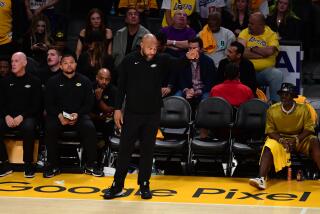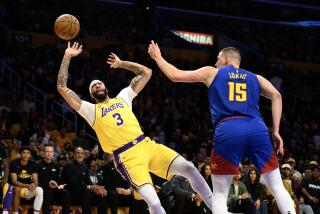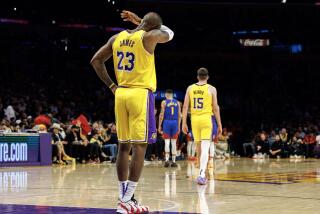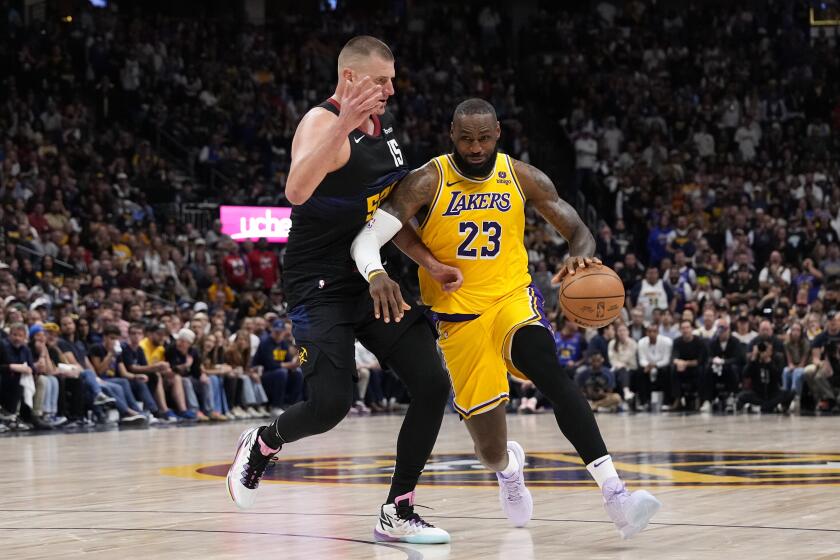A foot hold that spurs healing
Ow. Ow ow ow ow ow. The sharp heel pain of plantar fasciitis is all too familiar to court-stomping superstar dunkers and pavement-pounding regular Joes alike.
Now a study by a team of foot experts provides new evidence that a simple exercise can help give that pain the boot -- potentially bringing relief to the more than 2 million Americans hobbled annually by the injury.
Plantar fasciitis is caused by a small tearing, or micro-tearing, of the plantar fascia -- a rope-like band of fibrous tissue that runs from the heel to the toes and supports the arch. Caused by working or exercising on hard surfaces, it bedevils nurses, teachers and athletes of all stripes. Lakers guard Kobe Bryant has had it. So has Cardinals slugger Albert Pujols.
Unlike many overuse injuries caused by excessive strain, plantar fasciitis often follows relatively mild activity, such as standing, walking or jogging, on a hard surface. The injury is vexing because it can take from six to nine months to recover completely. For about 10% of unlucky sufferers, it takes longer.
The study, led by Dr. Benedict DiGiovanni, an orthopedic surgeon and associate professor of orthopedic surgery at the University of Rochester, tested a new exercise specifically designed to stretch the plantar fascia. DiGiovanni theorized that it might be more effective than the Achilles tendon stretch -- a common exercise for the injury.
The stretch involves curling the toes backward while flexing the ankle (see sidebar). In an earlier investigation published in 2003, he compared the exercise to the Achilles tendon stretch in an eight-week clinical trial of 82 patients who had suffered from plantar fasciitis for more than 10 months.
Patients were taught protocols for either the Achilles stretch or the plantar fascia stretch. After two months, the plantar fascia stretch group reported significantly less pain and more improvement in their condition than the Achilles tendon group, based on their responses to questions about pain and satisfaction with treatment.
DiGiovanni’s new study, published in a recent issue of the Journal of Bone & Joint Surgery, examined the progress, two years on, of 66 patients from the first study. All had been instructed in the proper way to perform the plantar fascia stretching exercise at the termination of the initial study.
Based on their responses, patients in the original Achilles tendon group who had been taught the plantar fascia stretch showed marked improvement, essentially catching up with the plantar fascia group. In all, 92% of patients in both groups reported total or near-total satisfaction with the treatment, and 94% reported a decrease in pain.
Dr. Timothy Charlton, an orthopedic surgeon and assistant professor of orthopedic Surgery at USC’s Keck School of Medicine, says he likes the stretch and recommends it to his plantar fasciitis patients.
Other treatments include icing; night splints (to keep the foot at a 90-degree angle while sleeping); orthotics and heel inserts; anti-inflammatory medications; shock wave therapy; and surgery.
The pain of plantar fasciitis tends to be most intense after periods of inactivity, such as in the morning, when first getting out of bed, or after extended sitting. During those periods, “the body tries to heal those micro tears,” DiGiovanni says. But the reverse can occur as soon as the sufferer gets up. Small movements, such as the simple act of walking , creates further tearing.
DiGiovanni believes that part of the success of his stretch is due to the fact that he recommends doing it immediately after getting out of bed and after other periods of inactivity -- before the damage is done.
The key to avoiding plantar fasciitis, say foot doctors, is to exercise conservatively; avoid hard surfaces (such as concrete and asphalt) both at work and at play; invest in a pair of good, supportive, properly fitted shoes; and replace them regularly.
DiGiovanni himself has experienced the pain of plantar fasciitis -- after a round of golf.
“I woke up in the morning, put that first step down, and said, ‘Oh my goodness, I’ve got it. I can’t believe I’ve got it.’ ”
Fortunately, he knew what to do. “I started the stretch right off the bat,” he says.
*
*
(BEGIN TEXT OF INFOBOX)
Recovery stretch
Got a hurtin’ heel? The following exercise can speed recovery from plantar fasciitis. The best time to do the stretch is immediately after the foot has been immobilized for a while, such as when you first get out of bed or the car.
* Sit upright in a chair, barefoot. Place the ankle of the affected foot on the opposite knee.
* Using the same hand as the affected foot, reach across and grab the toes.
* Flex the ankle forward and pull the toes toward shin.
* To test the stretch, place the thumb of your other hand on the bottom of the foot. You should be able to feel the cord-like plantar fascia running the length of the foot.
* Hold the stretch for a count of 10, then relax. Repeat 10 times. Perform the sequence at least three times a day.
-- Janet Cromley
More to Read
All things Lakers, all the time.
Get all the Lakers news you need in Dan Woike's weekly newsletter.
You may occasionally receive promotional content from the Los Angeles Times.






